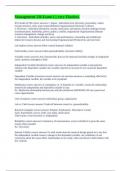Management 336 Exam 1 || very Flawless.
IPO model of OB correct answers 1. Inputs - Individual level (diversity, personality, value)
Group (structure, roles, team responsibilities) Organizational (Structure, Culture)
2. Processes - Individual (Emotions, moods, motivation, perception, decision making) Group
(communication, leadership, power, politics, conflict, negotiation) Organizational (Human
resource management, change practices)
3. Outcomes - Individual (attitudes, stress, task performance, citizenship and withdrawal
behavior) Group (cohesion and functioning) Organizational (Productivity and survival)
Lab studies correct answers More control (internal validity)
Field studies correct answers More generalizability (external validity)
Variable correct answers Any characteristic that can be measured and that changes in magnitude
(size), intensity (strength) or both
Independent Variable (Predictor) correct answers An independent variable is presumed to
influence the dependent variable, the variable expected to account for (or cause) the dependent
variable
Dependent Variable (criterion) correct answers An outcome measure or something affected by
the independent variable, the variable to be explained
Moderators correct answers A contingency or "it depends on" variable, causes the relationship
between the independent and dependent variable to vary
Ex: Maybe the relationship between pay and job satisfaction DEPENDS ON one's perceived
career opportunities
Unit of analysis correct answers Individual, group, organization
Lab vs. Field correct answers Trade-off between control vs. generalizability
Research strategies correct answers Purpose: Exploratory, Descriptive, Casual
Type: Experiment, survey, field, case study, observation
Time frame: cross-sectional vs. longitudinal
Reliability correct answers Consistency of measurement, a test is reliable if it gives the same
results when repeated
Ex: Test-retest
Internal Validity correct answers To what extent does the research design permit us to say that
the independent variable causes a change in the dependent variable, our confidence in our
conclusion about the cause-effect relationships in our study, often sacrificed in field studies with
few controls
, External Validity correct answers To what extent are the results transferable or generalizable to
field ("real world") settings?, Important when conducting research "in the lab"
Correlation correct answers Measure of the degree to which two variables are related
Coefficient - measure of the strengths of the relationship between two variables, ranges from -1
to +1, correlations provide evidence of Validity
Data analytic techniques: Correlation; T-test correct answers Correlation (-1 to 1)
Group correct answers two or more individuals, interacting and interdependent, who have come
together to achieve particular objectives
True correct answers Groups can be either formal or informal
Formal groups correct answers those defined by the organization's structure
Informal groups correct answers alliances that are neither formally structured not
organizationally determined
OCBs correct answers
Organization, Individual (Socialization, Social Identity) correct answers What needs are fulfilled
by groups?
Intuitive decision making correct answers
Group Properties correct answers Roles, Norms, Status, Size and Dynamics, Cohesiveness, and
Diversity
Roles correct answers a set of expected behavior patters attributed to someone occupying a given
position in a social unit
Norms correct answers acceptable standards of behavior within a group that are shared by the
group's members ex: norms and emotions, norms and conformity, norms and behavior, norms
and group outcomes
Status correct answers a socially defined position or rank given to groups or group members by
others
Status characteristics theory correct answers status is derived from one of three sources:
1.
2. being likeable
Cognitive dissonance correct answers
The 5 job attitudes correct answers




